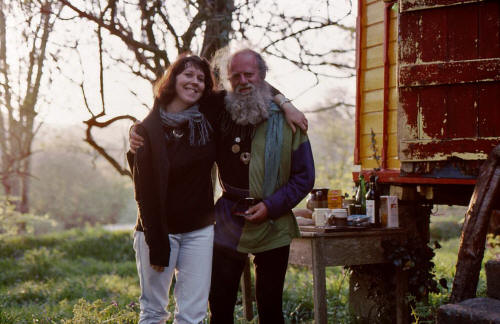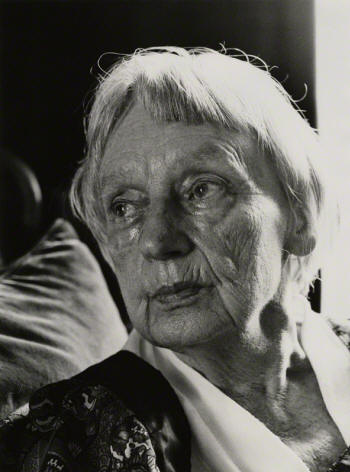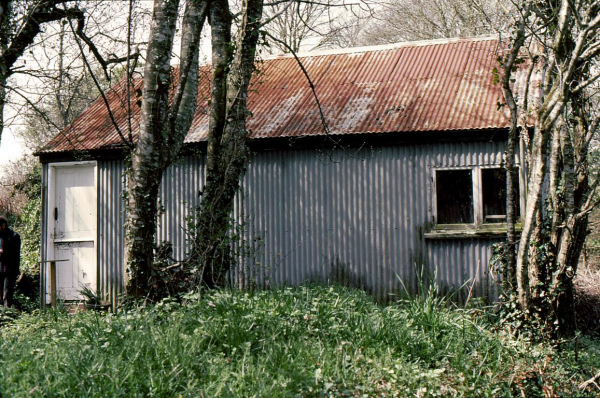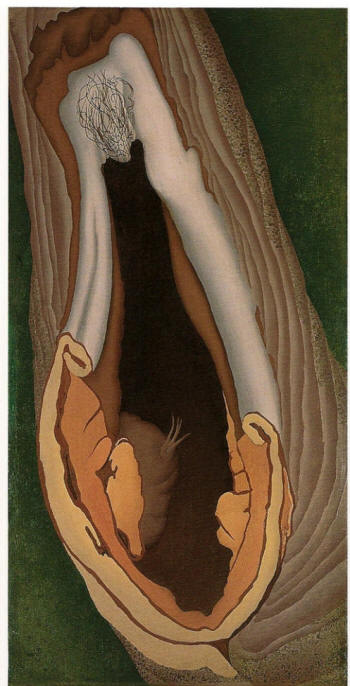|
|
| home | features | exhibitions | interviews | profiles | webprojects | archive |
|
Ithell Colquhoun and the alchemical transformation of Lamorna valley
Steve Patterson
Lamorna is an idyllic coastal valley in west Cornwall just beyond Penzance. I remember my first experience of walking down the wooded lane past Lamorna gate. It was an enchanted landscape. We turned down a grassy track over a bridge into an even more magical world, where amid the dappled light of the twisted hollies, oaks and hazels stood an old wooden caravan. The caravan, Jo informed me, was once, during the war, the home of a group of conscientious objectors. They had fled westwards hoping to get a passage to France with the local fishermen, but missed the tide and found themselves stranded high and dry in West Cornwall. They took up residence in the old caravan living off forestry work and rapidly became a small, politically radical, bohemian community. After the war the community all went their separate ways, but the memory of the “woodchoppers” became a semi-mythical feature of Lamorna history. The story, Jo informed me, was recorded by a woman by the name of Ithell Colquhoun (below left) in her book “The Living Stones – Cornwall”. He also informed me that this book was the reason he moved in to the valley. In time the book also became an inspiration to me, and was instrumental in my own move westwards to Cornwall.
Ithell Colquhoun is best known as a surrealist artist, a title with which she was never really comfortable for a number of reasons, not least her expulsion from the Surrealist movement in London due to her involvement with various magical and esoteric societies. She described herself as “A poet in words, collages, paintings and constructions”, but to me she was always first and foremost a writer, a magician and Celtic mystic. Much of this I found to be distilled within the pages of her book “The Living Stones”. She believed in a kind of esoteric Christianity, though was a devout animist with a great interest in Celtic paganism (of which it could be argued she was a great pioneer of the 20thC revival), she was also attached to a bewildering number of esoteric societies. The occult world to her was far more than just a passing fancy; it deeply informed both her philosophy and practice.
Although she failed to enter the Golden Dawn offshoots the “Alpha and Omega Lodge” and the “Society of the Inner Light”, she did however join the Thelemic offshoots “O.T.O”, “Nu Isis lodge” and “The Order of the Celtic Cross”. She also had masonic connections; she was a co-mason, in the “Order of the pyramid and sphinx” and - based in King Arthur’s Hall in Tintagel - she was in “The Lodge of the Holy Grail no.5”. In terms of druidry she knew Ross Nichols founder of O.B.O.D and was involved with “The Ancient Celtic Church”, “The Universal Bond” and “The Golden Section Order”. In the world of paganism she was a member of “The fellowship of Isis” but interestingly, although she knew both Gerald Gardner and Cecil Williamson, she seemed to have no interest of involvement with the then blossoming witchcraft revival. Ithell Colquhoun was born in India in 1906, moved to Britain as a child, trained as an artist and made her way in the world of art in London. She travelled extensively around the Mediterranean, but after the war moved to Lamorna. It was said that, apart from the artist communities of Penwith, the reason she gravitated to Cornwall was the fact that she had family connections in the area. It may be significant that her cousin (and indeed the head of ‘The Alpha and Omega Lodge’ in London of whom she was denied access to) was an E.J. Garstin. The big house at the head of Lamorna valley, not a stone’s throw from where she came to live, was owned by a Crosby Garstin (son of the painter Norman Garstin). One wonders as to whether this was not only a family, but also a magical connection.
Near Lamorna gate Ithell brought a ramshackle old hut with no facilities which she named “Vow Cave” after a great rock above the valley and converted into her home and studio (picture above). The hut was sadly demolished in the 1980s, but upon its footprint stands another small building, and one can still get a sense of what the old place was like. This was the place from which her work emanated; and it was the centre of the spider’s web that wove “The Living Stones”. Ithell Colquhoun believed that both human and non-human entities shared sentient qualities. The Lamorna valley to her was both a being in its own right and a source of inspiration. In an idiosyncratic style that sweeps effortlessly between prose and poetry, the outer landscape and inner mindscape, she describes it thus: “Valley of streams and moon-leaves, wet scents and all that cries with the owl’s voice, all that flies with a bats wing, peace! Influences essences, presences, whatever is here – in my name in the stream in a valley, I salute you: I share this place with you, stirrings of life, expanding spores, limbo of germination, for all you give me I offer thanks. O rooted here without time, I bath in you; genius of the fern-loved gully, do not molest me; and may you remain forever unmolested.”
In her work she deconstructs the landscape and reconstructs it in a mythological form. Also in accordance with alchemical principles there is no distinction between subject and object; as the vision of the landscape transmutes, so does the operator. Of her hut at night she says “There falls thy shadow Cynara, the night is thine - comes to mind and I know I am no longer mistress in my house, for another life will fill it till dawn.” And of the owls in the trees she tells “They seem to prefer the still moonlight nights for their consecration of Hecate’s secrets, her influence has remained here from ancient times, for moon-work hangs long among trees.” High on the moors beyond the valley she speaks of Carn Uny, the place where both the waters and the numen that feeds Lamorna valley rises. She says of the neglected spirit of St Uny: “Her strange powers, unused, seem to hover about the grey hill, the unchannelled water, the rank leaf.” Here she makes a rare reference to one of her artworks: “Interior Landscape”. And of the melancholic feel of Lamorna she tells - “Nature spirits were weeping: mistreated and misused by druidism in decay”.
But far from being bleakness in the land that would repel one from the place, it is a melancholia that compels the mind and stirs the soul. This may be in part because of the fact that in her mind the old megalithic stones, or ‘Carrek sans’(holy stones) around the valley somehow invigorated the landscape. She describes them as power houses of vital energy: “The earth is a being and certain places on its surface are conducive to different kinds of esoteric perception, these places are the mundane chakras of the earth itself.” These places of power in turn enter in to a kind of symbiotic relationship with the rock – hence the title of the book “The Living Stones”. These places she says: “Would draw upon a ‘Fountain out of Hecate’, an up rush of force from the macrocosmic underworld which focused by ceremony may coincide at precise times with the microcosmic unconscious.” Although these ideas may now be familiar to us, the idea of earth energy in the stones was, at the time, a radical new idea. Her belief in this, in the old stone crosses, the menhirs, the Merry Maidens, The Pipers and Bolleigh Fogou is implicit in her work. Prefiguring the idea of ley-lines (Alfred Watkins' “The Old Straight Track” had not long been published, and the idea of ley-lines possessing a psychic dimension had not yet been developed). She spoke of the power of these stones traveling in lines upon the land, and where the earth current meets the sea current “A whirlpool develops which stimulates health and visionary capacity.” And it is here that our journey both begins and ends, at Lamorna cove. Once a great quarry supplying granite for the building of London, it now lies slumbering and reclaimed by nature. Towards Carrek Dhu there lays the flat rocks where mermaids and woodchoppers once sported. On the beach below Atlantians came bringing their mysteries and leaving their enigmatic “plummet signs” upon the cliffs, and in the sea beyond fishermen made offerings to old Bucca, the god of the sea and in return came the sound of “Sweet thunder”. Where the car park now stands was once the altar where Ithell Colquhoun once worked her magical artes and eventually it was here that her funeral was held and her ashes cast in to the sea.
Steve Patterson is a folklorist, and author of 'Cecil Williamson's Book of Witchcraft'. See interview Thankyou to Richard Shillitoe for providing the images. |
|
|



 Someone
in the valley once told me that Ithell Colquhoun attended some kind of
esoteric group once a week on Thursday nights. I am not aware that she
drove a car, so presumably it would have been within walking distance.
So maybe there were "strange goings-on" at the big house! Another
candidate for the venue for these clandestine magical meetings could
possibly be “Wheal Betsy” which was situated two miles away at the top
of Paul Hill where Aleister Crowley’s last scarlet woman Pat Doherty,
and his favourite son Ataturk lived. She was known to be good friends
with Pat Doherty, and more than once I heard rumours of Wheal Betsy
being the seat of some kind of esoteric society.
Someone
in the valley once told me that Ithell Colquhoun attended some kind of
esoteric group once a week on Thursday nights. I am not aware that she
drove a car, so presumably it would have been within walking distance.
So maybe there were "strange goings-on" at the big house! Another
candidate for the venue for these clandestine magical meetings could
possibly be “Wheal Betsy” which was situated two miles away at the top
of Paul Hill where Aleister Crowley’s last scarlet woman Pat Doherty,
and his favourite son Ataturk lived. She was known to be good friends
with Pat Doherty, and more than once I heard rumours of Wheal Betsy
being the seat of some kind of esoteric society.